The King Charles II receives as a gift a ship named
in Netherland jacht, word transformed in yacht. The Cowes Yacht Club
is founded on the isle of Wight in 1815 and becomes the Royal Yacht Scadron
in 1833. It will organise around the isle of Wight a schooner race named
after the winner, the America's cup.
Sailing comes at Olympic Games at Athens in 1896 then at Paris in 1900 as
a demonstration and the first official competitions occurs in 1908 at
London.The ships used are first of the ton jauge then of the International jauge; in 1924
appears the first monotype (all ships are identical). The first dinghy
arrives in 1920 at Anvers and this kind of ship becomes in majority
after-war.
At Paris Olympic Games in 1900, sailing is scheduled with 0.5 ton,
0.5-1 ton, 1-2 ton, 2-3 ton, 3-10 ton, 10-20 ton, 20+ ton classes.
|
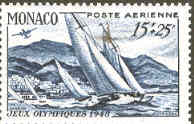
|
The race pictured on the stamp is a 8-metre class
regatta, which didn't participate to the London Games in 1948. |
|
|
The
5.50 metres jauge ships dimensions must respect the formula where the
result shall not exceed 5.50 metres:
0.9*((L*S^(1/2)/12/D^(1/3))+((L+S^(1/2))/4)) with:
L = Length for rating
S = Measured sail area between
26.500 m² and 29.000 m²
D = Displacement in m3; as
the weight , divided by 1025; it must be comprised between
1700 m3
and 2.000 m3
The 5.50 m J.I. is olympic during 5 Olympiads, from Helsinki
(1952) to Mexico (1968).
|
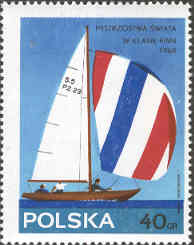
|
|
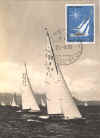
|
|
|
|
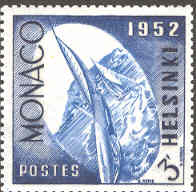 |
 |
 |
|
|
|
|
The open
double keelboat Star has been designed by the American William Gardner in 1911.
The oldest olympic ship, introduced at Los Angeles Games in 1932, the Star
has been always at Olympics, except in 1972 at Munich.
Length: 6,92 m
Beam: 1,73 m
Weight: 671 kg
Sail area: 25,73 m² including a main sail of 21.7
m² (i.e. the total sail area of Soling) and a foc of 4.03 m²
|
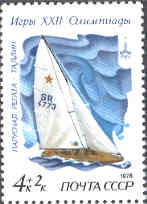 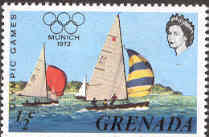
|
|
|
|
|

|
The Dragon Olympic Sail
Racer was originally designed by Johan Anker in 1929. In 1948 the
Dragon became an Olympic Class, which is held until the 1972
Olympics.
Length 8.9m
Beam 1.95m
Draugh 1.2m
Displacement 1700kg (with mast)
Main sail 16m²
Genoa 11.7m²
Spinnaker 23.6m²
|
|
|
|
The International Tempest is a 22-foot, two-man, high-performance keelboat equipped with spinnaker and trapeze.
Its powerful, high aspect ratio rig and efficient hull enable it to sail upwind at almost seven knots and tack through less than 90 degrees. It’s best known for its offwind speed, however—it can plane in as little as 13 knots of wind and surf in much less—and its heavy air performance once led an editor of Yachting to call it "the fastest one-design keelboat, period!"
|
It weighs little more than 1000 lbs.; its fiberglass hull weighs less than 500 lbs., its fin keel weighs about the same, and its 30-ft. aluminum mast adds about 30 lbs. On its trailer, its towing weight is normally less than 2000 lbs.
The Tempest’s main and jib total 247 sq.ft., and its spinnaker adds 225 sq.ft. more. In
double, she is olympic class replacing Star at Kiel 72 and Montréal
76 (bronze medal for Denis Conner).
Length 6,70 m
Beam 1,97 m
Draugh 1,1
m
23 m2 of sail ;
Weight 450 kilos
|

|
|
|
|
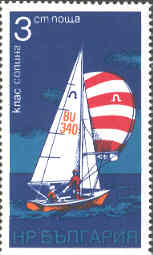
|
Olympic class since 1972, the SOLING is the unique open triple
keelboat at Games.
Length: 8.20 m
Beam: 1.90 m
Weight: 1035 kg
Sail area: 21.70 m² include a main sail of 13.60 m², a foc of 8,10 m²
and a spi of 30/40
m².
|
|
|
|
|
The Firefly is 12' long, suits a crew weight of 17-24
stone, and has no spinnaker. Being selected for the single
handed class at the 1948 Olympics to be held at London, after a very
windy week the boat proved a handful for just one, and was replaced
in 1952 by the heavier Finn class.
|
|
Constructed in Finland by Rickard Sarby (Sweden) in 1949, FINN
a men's solo dinghy has been an Olympic class since the 1952 Summer Olympics.
Length: 4.5 m
Width: 1.51 m
Sail area: 10 m2
Hull
Weight: 105 kg (before ~1990 145 kg)
|

|
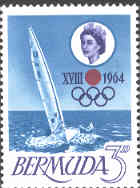 |
|
|
|
|
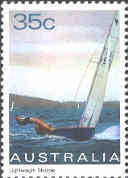 |
In 1956, at Melbourne,
on the 12 sq m Sharpie (doublehander dinghy) English (bronze),
Australians (silver) and New-zealanders (gold) share the podium. Length:
5.99 m
Beam: 1.43 m
Mast heigth : 4.85 m
Geared as a sloop
Sails: Main &
Jib with a total area of 12 m²
No spinnaker
Hull Weight: 230 |
|
|
| In 1957 the Flying Dutchman (FD) was selected to replace the
Sharpie at the 1960 Olympic Games in Naples. The Pajot brothers
got the silver medal at Munich in 1972.
Length: 6.05 m
Beam: 1.70 m
Weight: 160 kg
Sail area: 22 m²
|
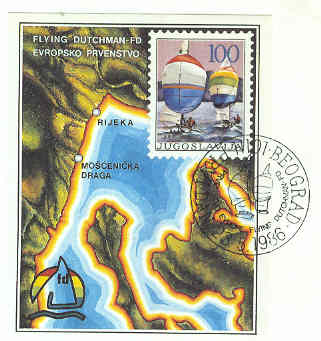 |
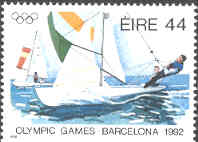
|
|
|
 |
The 470 is a monohull planing dinghy with centreboard, bermudan rig and center sheeting, designed for a crew of
two in 1963 by André CORNU; the
470 is born in France, at Quiberon. The name is the overall length of the boat in centimeters (i.e. the boat is exactly 4.7 meters long). The 470 has been an Olympic class since the 1976
games at Montréal . The Class was initially an open class, but since the 1988 games there has been separate events for men and women. Construction is from Glass-reinforced plastic with integral buoyancy tanks; the foredeck is a weak point in the design and should not be expected to support any weight (in other words, don't tread on the foredeck).
Length: 4.70m
Beam: 1.70 m
Weight: 118 kg
Mast heigth: 7.10 m
Sail area: 12.70 m2 include Main sail: 8.75 m
Foc : 3.85 m²
Spi: 14 m²
|
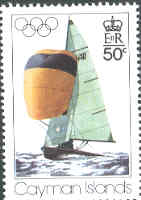 |
The Laser, an
open solo dinghy designed by the American Bruce Kirby en
1972, became an Olympic-class boat in 1996 at Atlanta, and a special Olympic edition of the boat was released that year in commemoration.
Length: 4.23 m
Beam: 1.37 m
Weight: 56.7 kg
Mast heigth: 6.46 m
Sail area: 7.06 m2
|

|
|
|
 |
Tornado, the sole catamaran
at Games, designed by the English architecte Rodney March in 1967,
is an open double multihull. Since 1992, the olympic authorities
have open the competitions to mixed crew or entierely feminine
crew.
Length: 6.09 m
Beam: 3.05 m
Weight: 145 kg
Sail area: 16.87 m²
Foc: 5.20 m² ) |
|
|
|
|
| The sailboard appaears
as olympic at Los Angeles (1984) for the men, and at Barcelone
1992 for the women. After the Lechner (first type of sailboard,
used at Séoul and Barcelone), it is decided to adopt the Mistral,
ideal for the race. Length: 3,72 m
Beam: 0,64 m,
Weight: 17 kg, sail area: 7.40 m2
The Mistral are 4.24 metres long and 1.3 metre beam. |
|

|
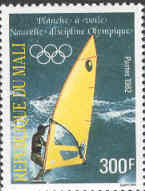
|
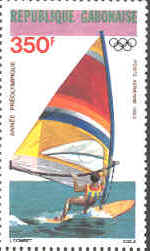
|
|
|
|